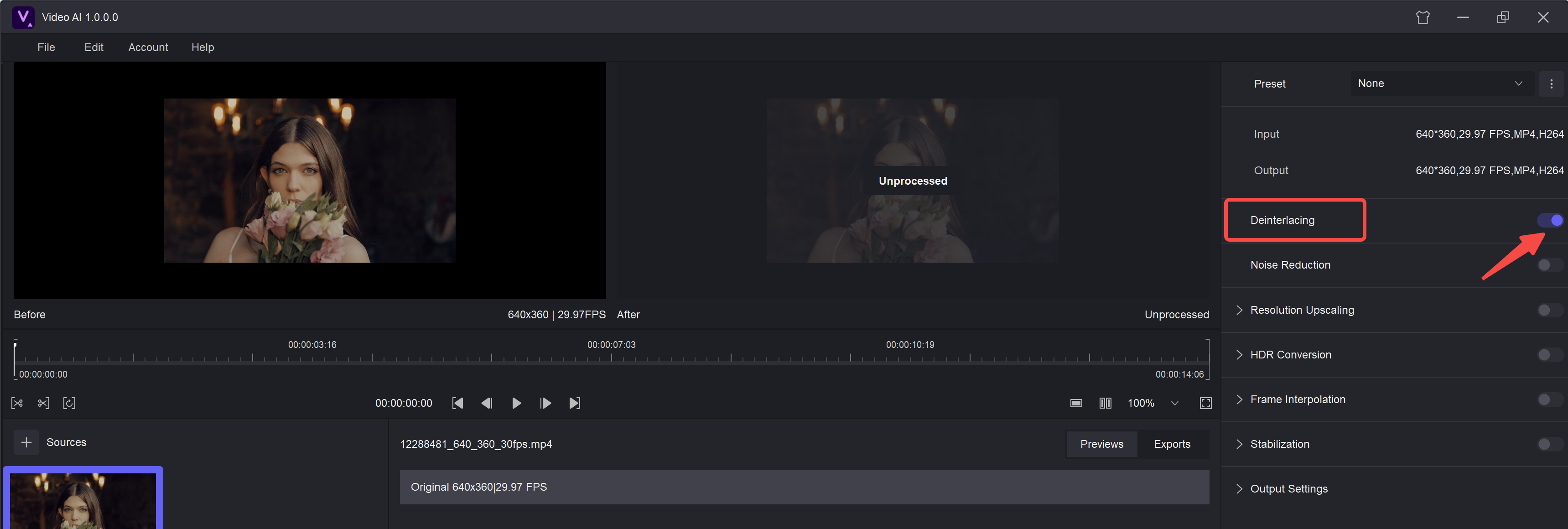¶ 2.7 Deinterlace
¶ 2.7.1 Function Introduction
Functions:
- Deinterlacing: Fixes interlaced videos by converting them to progressive, removing jagged lines and artifacts from older formats.
- Upscaling: Boosts video resolution to HD or 4K, making visuals sharper and clearer.
- Motion Artifact Removal: Reduces motion blur and other issues that affect video quality.
- Edge Blur Reduction: Sharpens edges for a crisper, more detailed image.
Applications:
- Home Video Enthusiasts: Upgrade old home videos to better quality and modern formats.
- Content Creators: Improve video quality for online platforms and presentations.
- Professional Video Production: Enhance archival footage and get videos ready for broadcast or distribution.

¶ 2.7.2 Test Example for Processing Speed
Speed Explanation
The following are our test results for your reference only.
| GPU | Quality enhancement (without resolution upscaling) | Enlarge to 1080p | Enlarge to 4K |
| GTX 1660 | 4 times the length of the original video | 5 times | 5 times |
| RTX 3070 | 2 times | 2 times | 3 times |
| RTX 4080 | 2 times | 2 times | 2 times |
Using AMD or Intel graphics chips to deinterlace, it shows a similar speed as NVIDIA graphics cards of similar level.
System Requirements
| Operating System | System Memory(RAM) | Graphics Cards | CPU |
| Windows 11/10(64 bit only) | 16GB or more | Nvidia RTX 30 series or higher, 8GB VRAM | Intel i7 8th generation or AMD Ryzen 3000 series or higher |
| Mac OS 13.0 and higher | 32GB | MacOS Intel: Dedicated GPU from 2015 onward; MacOS Silicon: Apple M-series | MacOS Intel: Intel with AVX instructions; MacOS Silicon: Apple M-series |
¶ 2.7.3 FAQs
What is Deinterlace?
Deinterlace uses artificial intelligence to turn interlaced video into progressive video, improving quality and reducing motion issues.
What are the benefits of using Deinterlace?
It boosts video quality, adds detail, improves clarity, and lets you enjoy older videos in a modern format.
What’s the difference between interlaced and progressive video?
- Interlaced: Frames are split into two fields—one with even lines and one with odd lines.
- Progressive: Each frame shows in full, making the image smoother and clearer.
What videos can Deinterlace AI handle?
It works with MP4 and MKV formats. The output quality depends on the original resolution and compression.
Why did the process fail?
Failures might happen due to unsupported formats, corrupted files, or low system resources. Check the format and your system specs.
Can I process multiple videos at once?
Yes! Deinterlace supports batch processing. You can load multiple videos, and it will process them one by one.
Will the video lose quality during the process?
No, Deinterlace enhances quality while processing, so your video will look better, not worse.